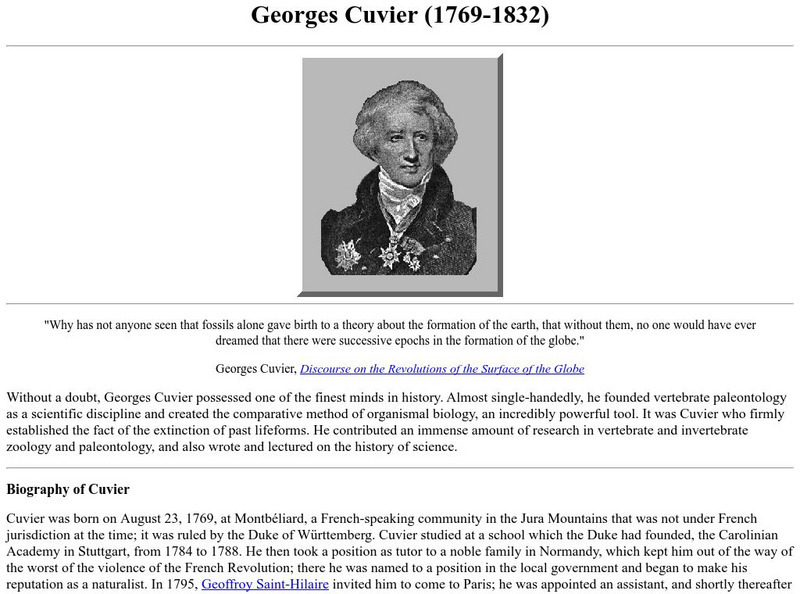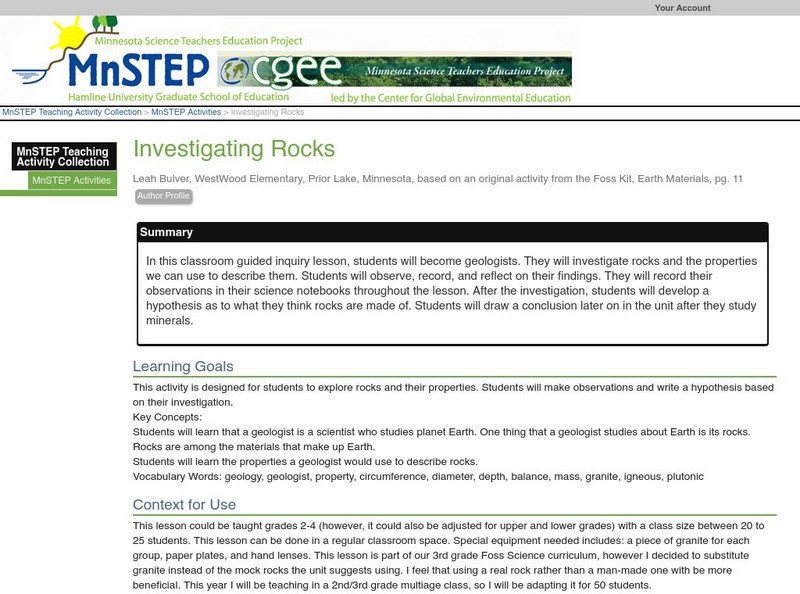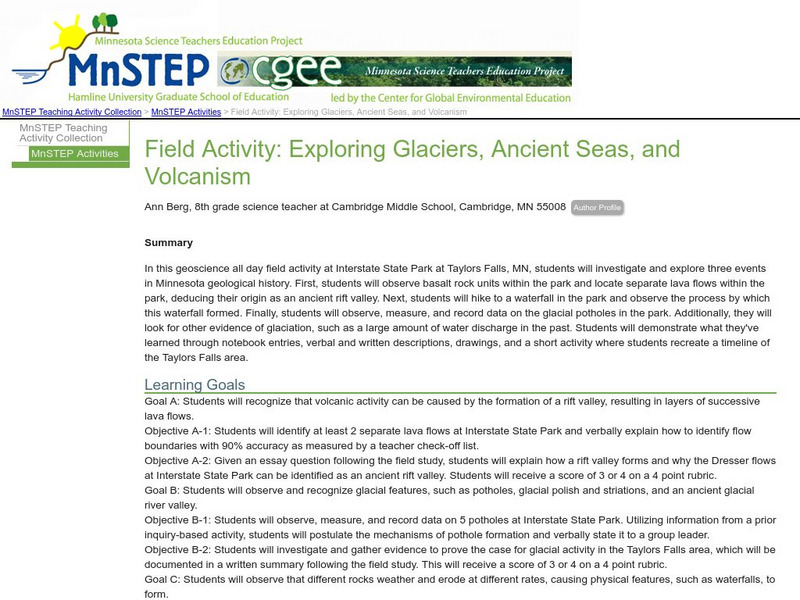American Geosciences Institute
American Geological Institute: Evolution and the Fossil Record
The American Geological Institute has done an excellent job of defining and explaining evolution in this online booklet. Darwin, fossils, natural selection, and change over time are some of the concepts that are covered. Make sure to see...
PBS
Wnet: Thirteen: Savage Earth: Volcanoes Out of the Inferno
PBS's The Savage Earth provides online learning associated with the series including vivid pictures, animations, and detailed information about volcanoes. Learn about the formation and causes of volcanoes as well as the characteristics...
Other
New Mexico Bureau of Geology & Mineral Resources: Lite Geology
Lite Geology is a publication for teachers that is available intermittently and can be freely downloaded. Previous issues going back to 1992 are also posted. Lots of information about geology, particularly in New Mexico, along with...
Natural History Museum
The Natural History Museum, London, England
Great site providing a "Quickindex" to find various resources. Also included are links to more information on this museum.
US Geological Survey
Usgs: Pocket Texas Geology
The interactive map from the USGS, along with the Texas Natural Resources Information System (TNRIS) and the Texas Bureau of Economic Geology, provides satellite images of Texas' rock units, members, faults, and map sheets. Explore Texas...
Other
Caterpillar: Ground Rules: Mining Right for a Sustainable Future [Pdf]
This set of lesson plans was developed to accompany Ground Rules: Mining Right for a Sustainable Future, a documentary film created by Caterpillar and Science North. They introduce students to the various phases involved in mining,...
University of California
Ucmp: Online Exhibits
Visit the virtual exhibits at this site to learn more about paleontology, the history of the earth, and life on earth. Use the information on this site to understand geology, geologic time, evolution, and phylogeny.
CK-12 Foundation
Ck 12: Flex Book Textbooks: Earth Science Concepts for Middle School
[Free Registration/Login may be required to access all resource tools.] A complete, web-based, multi-media textbook covering a wide variety of Earth science concepts for middle grades.
Other
Digital Library for Earth System Education (Dlese)
This resource provides materials for teachers on a huge array of topics. Search site by topic, grade level, and desired output (such as lesson plan, case study, assessment or tutorial). Site is focused on earth science, geography, and...
CK-12 Foundation
Ck 12: Rocks and Processes of the Rock Cycle
[Free Registration/Login may be required to access all resource tools.] Instructional videos, grade-level texts, interactive activities, and quick assessments about rocks and processes of the rock cycle.
Cengage Learning
Geology Link
A geology news site that is updated daily with news on the latest geological happenings, such as earthquakes. It also has virtual field trips and a glossary of geology terms.
Lawrence Berkeley National Laboratory
Berkeley Lab: The Fruitful & Inventive Mind of Scientist Luis Alvarez
This article, reprinted from the fall 1979 LBL News Magazine, was written about Dr. Luis Alvarez and his part in the study of geological sediments and the great extinctions.
University of California
Ucmp: Georges Cuvier
This site from the University of California, Berkeley offers a biography of George Cuvier. Scientific ideas of George Cuvier are presented, such as those related to comparative anatomy, fossils, the idea of extinction, and others....
University of California
Ucmp: Georgius Agricola
This site from the University of California provides a review of the life and contributions of Georgius Agricola (1494-1555) the 'founder of geology as a discipline'.
Science Buddies
Science Buddies:testing Compression Waves
Here's a project for studying compression waves in different soil types. It uses a homemade wave tank for solids, with a frequency generator, amplifier, and loudspeaker as the vibration source. There are lots of interesting possibilities...
Science Buddies
Science Buddies: Porosity
Soils are made of particles of different types and sizes. The space between particles is called pore space. Pore space determines the amount of water that a given volume of soil can hold. Porosity is the percentage of the total volume of...
Science Buddies
Science Buddies: Composting and Vermiculture
Make your own fertile soil using kitchen scraps, manure, leaves, grass clippings, and other compostable materials. Which materials make the best compost?
Science Education Resource Center at Carleton College
Serc: Crumbling Rocks: Observing and Describing Rocks
Introduce geological terminology used in describing rocks to young students by having them observe and describe something they are familiar with to help them observe and describe the physical characteristics of something unfamiliar like...
Science Education Resource Center at Carleton College
Serc: An Investigation Into Geologic Mapping: Quarry Park
In this geology field lab, students will map an area around Quarry 12 and Quarry 13 in Quarry Park. Using a field notebook, students will take field observations to later produce a basic geologic map, topographic map, and a...
Science Education Resource Center at Carleton College
Serc: Investigating Rocks
In this classroom guided inquiry lesson, students will become geologists. They will investigate rocks and the properties we can use to describe them. Students will observe, record, and reflect on their findings. They will record their...
Science Education Resource Center at Carleton College
Serc: Field Activity: Exploring Glaciers, Ancient Seas, and Volcanism
In this geoscience all day field activity at Interstate State Park at Taylors Falls, MN, students investigate and explore three events in Minnesota geological history.
Science Education Resource Center at Carleton College
Serc: Geology of the Grand Canyon: Interpreting Its Rock Layers and Formation
Learners are challenged to interpret the rock layers and formation of the Grand Canyon, to discover what geologic processes took place to form the rock layers of the Grand Canyon.
Science Education Resource Center at Carleton College
Serc: Getting to the Point: Exploring Tectonic Motion Point Reyes Seashore
The intent of this module is for students to make straightforward numerical calculations as they learn about earthquake geology at a National Park.
Science Education Resource Center at Carleton College
Serc: Westward Ho! How Far Is Yonder Mountain
In this lesson quantitative skills in geologic context are reinforced. Students create a spreadsheet to calculate the distance of a peak using vertical angles sighted from a wagon train heading directly for the peak. The spreadsheet also...







![Caterpillar: Ground Rules: Mining Right for a Sustainable Future [Pdf] Lesson Plan Caterpillar: Ground Rules: Mining Right for a Sustainable Future [Pdf] Lesson Plan](https://d15y2dacu3jp90.cloudfront.net/images/attachment_defaults/resource/large/FPO-knovation.png)

















